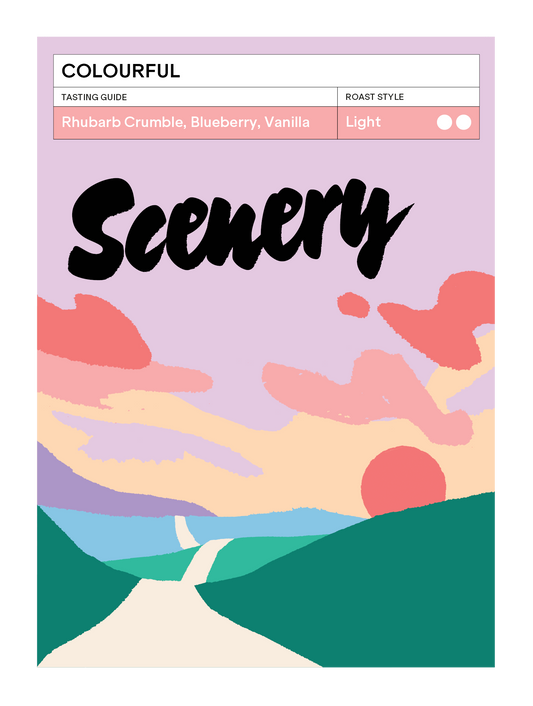Our very first Ethiopian release comes from an extremely high altitude kebele in the famous Hambella region of Guji. We’ve picked a coffee that brings back the most happy nostalgia - tasting to us like the flavours of Ethiopian coffee that first converted us to speciality coffee all those years ago - a clean and clear blueberry note, tropical fruit, florals and intense sweetness.
Brew Guide:
Best Brewed with: Filter
We’re chasing that blueberry note and the tropical sweetness that we find in this coffee. Extremely small, dense beans from the high altitudes means that this coffee shines from a fast, light roast - which means there’s two ways to go about brewing it. Either go 70g/L and coarser, concentrating syrupy berry sweetness, or try 55g/L with a standard grind, focusing on tropical fruit and florals.
As espresso, we recommend 18g in, 45-48g out in 30-34s
We taste: Blueberry with a distinct sweet cake note, like blueberry muffins. There’s lots of complex tropical fruit character, some bright orange citrus, and florals rounding it all out.
Traceability
Country of Origin: |
Ethiopia |
Region: |
Guji, Hambella woreda, Buku Kebele |
Producer Group: |
450 Smallholder farmers selling cherry to Hurufa CWS, Lulo Coffee |
Farm: |
Buku Hurufa CWS |
Variety: |
JARC 74110, 74112, 74158 |
Elevation: |
2100-2300 MASL |
Process: |
Natural |
Import Partner: |
Sucafina |
The Story:
There’s a famous animated film from Disney with a Gallic rodent chef - bear with us on this one - where the climax of the film sees a dour food critic try one of his childhood dishes, eponymous of the film itself, and is instantly, exultingly taken back to that nostalgic and perfect childhood moment; warmth, love and joy flooding back into his cynical world. Trying this lot from the Buku Hurufa station did the same thing to us - nostalgic blueberry flavours taking us back to the first time we had the experience of trying “coffee, but not like we knew it”
The Buku kebele (village/district) is located in the Hambella woreda (wider municipality) of the Guji zone, in southern Ethiopia.
Each area is famously well known for its unique characteristics of the coffees produced - a combination of specific variety choices, altitude and weather patterns. Coffee people often somewhat incorrectly reach for comparisons and terminology from the wine industry, but if ever there was a country that could justify it, it would be the unique character of coffees produced from the various woredas of Ethiopia, birthplace of coffee.
Guji is well known for its fruity & floral natural (sun-dried, whole cherry) coffee - a combination of arid to semi-arid climate and high elevations lead to dense, concentrated cherries, with the perfect climate for stable post-harvest drying over the several weeks it takes to dry when the fruit is kept whole. This style is particularly suited for areas with lower rainfall - as washed/wet process coffees require considerable amounts of water, that requires considerable processing before released back into the environment, as in its raw state is an eco-toxic pollutant.
The Hurufa station itself was built in 2020 by Lulo coffee, a vertically integrated private exporter run by Robel Kidane. The station sits on a flat field at 2120 MASL in the Buku kebele, nestled against a knee of the Awata river. Not wanting to pollute the clean river waters with the effluent produced by washed process coffees, Hurufa was built to only process natural and anaerobic natural coffee, which leads to an additional benefit of a minimal environmental footprint.
Buku itself (meaning “dust” - named for the dust kicked up by cattle herders moving their herds through the region) sits at an exceptionally high altitude, with the highest peaks reaching 2500 MASL. The highest farms supplying Hurufa sit between 2270-2290 MASL, with food and cash crops grown above the line where coffee yields start to drop. Coffee cherries take longer to mature at these high altitudes, meaning the harvest is delayed and the quality exceptional. Smallholder farmers deliver cherry to the station, upon which it is floated in a tank of water to remove underripes, damaged cherries and any sticks or leaves. The sorted cherries are then laid on African beds & raked frequently to control drying. Lulo coffee utilises infrared thermometers and portable moisture meters to control the drying process, ensuring that the best possible practices are followed and the coffee is stable.
Farmers in the Buku region mainly grow the JARC (Jimma Agricultural Research Centre) selected cultivars 74110, 74112, 74158. The codes correspond to the year the seed was selected and the specific seed line - for example, '74' denotes the selection year (1974) and the last three digits represent the seed line. All three of these cultivars have been derived from seeds collected from “mother trees” in the Metu-Bishari forest.
They are dwarf varieties with small cherries and display a strong resistance to coffee berry disease, also producing higher yields. These traits, when combined with the high altitude conditions found in Buku, result in the production of tiny, dense beans. These beans typically fall into the screen size of 13/14, making them among the smallest size grading you can find for commercially exported coffee.
This coffee was brought to the UK via our import partners Sucafina, having contracted it the day it was unloaded in the warehouse we’ve been itching to get this exceptional coffee out - hopefully we can share some nostalgia with those who know those classic ethiopian flavours, and create some new memories for those who don’t.

![[04] Ethiopia - Buku Hurufa [CROP 22/23 ARCHIVE]](http://scenery.coffee/cdn/shop/articles/Ethiopia_Buku_shopify.png?v=1714045400&width=1100)
![Colombia - Quebraditas Ají Thermal Shock Washed [FESTIVE SPECIAL] 🎄](http://scenery.coffee/cdn/shop/files/colombia_quebraditas_aji_shopify.png?v=1764358600&width=533)






![Colombia - Quebraditas Sidra Thermal Shock Washed [25/26]](http://scenery.coffee/cdn/shop/files/colombia_quebraditas_sidra_2526_shopify.png?v=1765544630&width=533)



![Colombia - Luz Ángela's Chiroso [25/26]](http://scenery.coffee/cdn/shop/files/colombia_luz_angela_chiroso_2526_shopify.png?v=1764359755&width=533)


![Colombia - El Jaragual Rosado [25/26]](http://scenery.coffee/cdn/shop/files/el_jaragual_rosado_2526.png?v=1757075842&width=533)